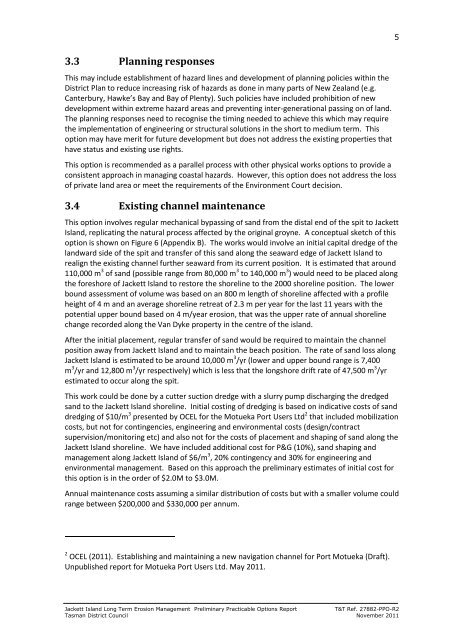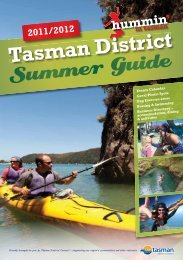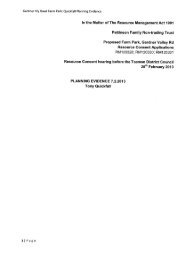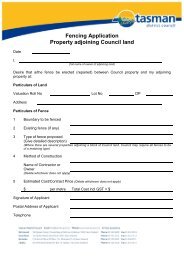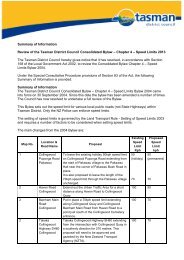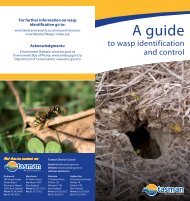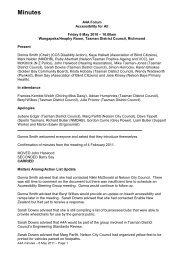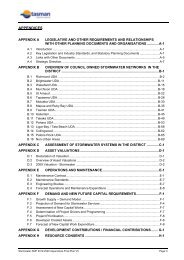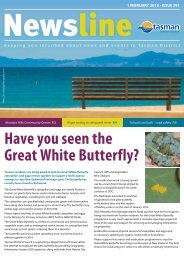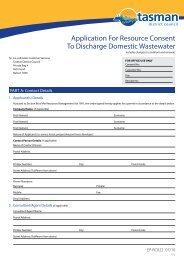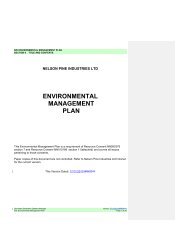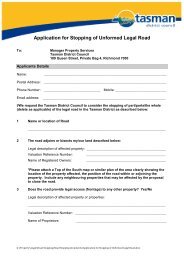RESC11-12-02 Port Motueka Groyne-Jackett Island Erosion ...
RESC11-12-02 Port Motueka Groyne-Jackett Island Erosion ...
RESC11-12-02 Port Motueka Groyne-Jackett Island Erosion ...
You also want an ePaper? Increase the reach of your titles
YUMPU automatically turns print PDFs into web optimized ePapers that Google loves.
3.3 Planning responses<br />
This may include establishment of hazard lines and development of planning policies within the<br />
District Plan to reduce increasing risk of hazards as done in many parts of New Zealand (e.g.<br />
Canterbury, Hawke’s Bay and Bay of Plenty). Such policies have included prohibition of new<br />
development within extreme hazard areas and preventing inter-generational passing on of land.<br />
The planning responses need to recognise the timing needed to achieve this which may require<br />
the implementation of engineering or structural solutions in the short to medium term. This<br />
option may have merit for future development but does not address the existing properties that<br />
have status and existing use rights.<br />
This option is recommended as a parallel process with other physical works options to provide a<br />
consistent approach in managing coastal hazards. However, this option does not address the loss<br />
of private land area or meet the requirements of the Environment Court decision.<br />
3.4 Existing channel maintenance<br />
This option involves regular mechanical bypassing of sand from the distal end of the spit to <strong>Jackett</strong><br />
<strong>Island</strong>, replicating the natural process affected by the original groyne. A conceptual sketch of this<br />
option is shown on Figure 6 (Appendix B). The works would involve an initial capital dredge of the<br />
landward side of the spit and transfer of this sand along the seaward edge of <strong>Jackett</strong> <strong>Island</strong> to<br />
realign the existing channel further seaward from its current position. It is estimated that around<br />
110,000 m 3 of sand (possible range from 80,000 m 3 to 140,000 m 3 ) would need to be placed along<br />
the foreshore of <strong>Jackett</strong> <strong>Island</strong> to restore the shoreline to the 2000 shoreline position. The lower<br />
bound assessment of volume was based on an 800 m length of shoreline affected with a profile<br />
height of 4 m and an average shoreline retreat of 2.3 m per year for the last 11 years with the<br />
potential upper bound based on 4 m/year erosion, that was the upper rate of annual shoreline<br />
change recorded along the Van Dyke property in the centre of the island.<br />
After the initial placement, regular transfer of sand would be required to maintain the channel<br />
position away from <strong>Jackett</strong> <strong>Island</strong> and to maintain the beach position. The rate of sand loss along<br />
<strong>Jackett</strong> <strong>Island</strong> is estimated to be around 10,000 m 3 /yr (lower and upper bound range is 7,400<br />
m 3 /yr and <strong>12</strong>,800 m 3 /yr respectively) which is less that the longshore drift rate of 47,500 m 3 /yr<br />
estimated to occur along the spit.<br />
This work could be done by a cutter suction dredge with a slurry pump discharging the dredged<br />
sand to the <strong>Jackett</strong> <strong>Island</strong> shoreline. Initial costing of dredging is based on indicative costs of sand<br />
dredging of $10/m 3 presented by OCEL for the <strong>Motueka</strong> <strong>Port</strong> Users Ltd 2 that included mobilization<br />
costs, but not for contingencies, engineering and environmental costs (design/contract<br />
supervision/monitoring etc) and also not for the costs of placement and shaping of sand along the<br />
<strong>Jackett</strong> <strong>Island</strong> shoreline. We have included additional cost for P&G (10%), sand shaping and<br />
management along <strong>Jackett</strong> <strong>Island</strong> of $6/m 3 , 20% contingency and 30% for engineering and<br />
environmental management. Based on this approach the preliminary estimates of initial cost for<br />
this option is in the order of $2.0M to $3.0M.<br />
Annual maintenance costs assuming a similar distribution of costs but with a smaller volume could<br />
range between $200,000 and $330,000 per annum.<br />
5<br />
2 OCEL (2011). Establishing and maintaining a new navigation channel for <strong>Port</strong> <strong>Motueka</strong> (Draft).<br />
Unpublished report for <strong>Motueka</strong> <strong>Port</strong> Users Ltd. May 2011.<br />
<strong>Jackett</strong> <strong>Island</strong> Long Term <strong>Erosion</strong> Management Preliminary Practicable Options Report<br />
T&T Ref. 27882-PPO-R2<br />
Tasman District Council November 2011


